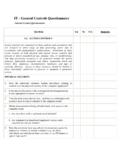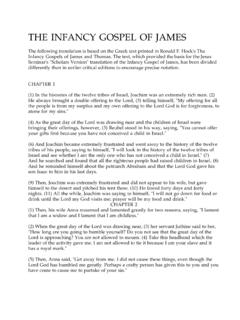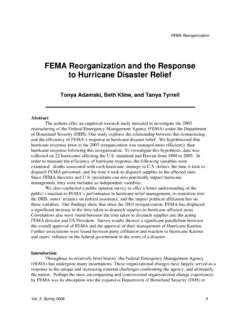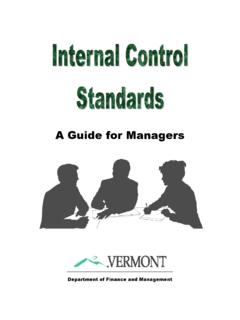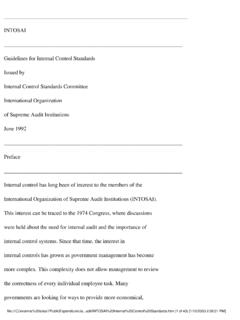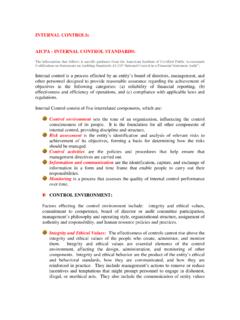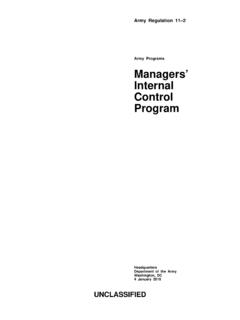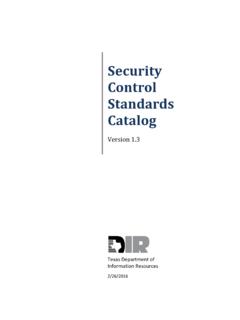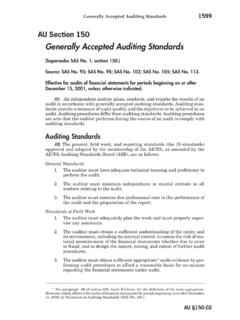Transcription of Standards of Internal Controls - ASU
1 Standards OF Internal control Issued April 2007 Table Of Contents I. Preface II. Objective III. Scope IV. Process V. Responsibility VI. Fraud VII. Revisions Introduction General control Requirements Quick Reference Revenue Cycle Order Entry/Edit Loan/Financial Aid Billing Accounts Receivable Collection Cash Receipts Procurement Cycle Supplier Selection and Retention Purchasing Receiving Accounts Payable Disbursements Payroll Cycle Human Resources, Compensation.
2 And Benefits Payroll Preparation and Security Payroll Disbursement Controls Distribution of Payroll Financial Reporting Cycle Accumulation of Financial Information Processing and Reporting of Financial Information Related Party Accounts Computer Systems Controls System Owners and Custodians of Equipment Physical Security and Environmental Controls Computer Access Security Network Security Systems Development Methodology Configuration Management Computer Operations and Back-up Disaster Recovery Planning Input Controls Processing Controls Output Controls Paperless Transaction Processing Environment.
3 Health and Safety Miscellaneous Cycles Capital Assets Subsequent Additions/Future Use Loss Prevention Cycle Physical Security Access Controls Personnel Security Physical Asset Protection Protection of Trademarks/Logos Intellectual Property Acknowledgement: The model used within this document is based off that of Motorola, Inc and is being used with their permission. I. PREFACE Our university has long had a formal statement of policy regarding the maintenance of an adequate system of operating and financial Controls .
4 The Standards of Internal control (SIC) were developed to serve as a resource to help document our continued commitment to compliance with applicable university and Arizona Board of Regents (ABOR) policies/procedures, local, state and federal laws and regulations, reliable operational and financial reporting, and integrity of our activities and records. An overview of our System of Internal control and the external environment it relates to is provided below. FINANCIAL Controls ABOR AUDIT COMMITTEECODE OF CONDUCT Standards OF Internal control FINANCIAL FUNCTIONS/MANAGEMENT AUDITOR GENERAL OFFICEUAAS COMPLIANCE HOTLINE OPERATING MANAGEMENT SELF AUDIT REVIEWS (ICQ S)
5 STUDENTSABORGood Business PracticesENVIRONMENTGASBLAWS AND REGULATIONSAZ TAXPAYERSMONITORING AND EVALUATINGABOR/ASU POLICIES AND PROCEDURESIMPLEMENTATION AND REVIEW This represents the first edition of the SIC, which was published to help ensure we meet the control requirements necessitated by the ever-changing environments in which we operate. It is based on the Internal control Standards published by Motorola, Inc., and is used with their permission. II. OBJECTIVE Good Internal Controls are fundamental to achieving our key initiatives and goals. Utilizing good Controls as included in this document can help eliminate bottlenecks, redundancies, and unnecessary steps.
6 Controls can prevent loss of resources, including capital assets, inventory, proprietary information, and cash. They can help ensure compliance with applicable laws and regulations. Periodic audits against the control guidelines can ensure that a process in control stays in control . The objective of this document is to provide a resource to our citizenry that will help assure the existence of basic and consistent Internal Controls throughout the university. This initial edition of the Standards of Internal control is the product of the continued efforts of numerous associates in various functions throughout the university.
7 The control criteria included were written in a manner to satisfy the basic objectives of our system of Internal control . This system recognizes the need to comply with the expectations of our students, alumni, vendors, faculty/staff and our community. The Audit Committee of the Arizona Board of Regents, the State of Arizona Office of the Auditor General, University Audit and Advisory Services, (UAAS), the Financial Controls division of Financial Services and each Business Administrator (BA) across the university are responsible for monitoring our adherence to these Standards .
8 III. SCOPE These Standards are applicable to all campuses, colleges, services and departments. The Standards generally reflect control objectives and do not attempt to describe the specific techniques required in each area. These Internal Controls are designed to provide reasonable, but not absolute, assurance regarding the safeguarding of resources, reliability of operating and financial information, and compliance with laws and regulations. The concept of reasonable assurance recognizes that the cost of a control should not exceed the benefit to be derived. It also recognizes the need for uncompromising integrity, good business judgment, and a culture of good control practices.
9 In management's selection of procedures and techniques of control , the degree of control employed is a matter of reasonable judgment. When it may be impractical or impossible to institute any of the Controls listed, as could be the case of a small or remote operation/department, management should choose among the following alternatives: Improve existing Controls through increased supervision and audits; Institute alternative or compensating Controls ; and/or Accept the risks inherent with the control weakness. IV. PROCESS The Controls in this document should not, as indicated by the Internal control wheel, be considered to be "stand alone".
10 Together, Internal control Standards , university policy and procedures manuals, and departmental rules should be considered part of the process for installing, maintaining, and improving our system of Internal control . The Internal control process should be supported by a commitment from all levels of the university. The process itself should include operational analysis, development of control procedures and techniques, communication, and monitoring. Operational analysis requires evaluation of risks and a determination of the appropriate control objectives. Also, the operating environment (such as level of automation, budget and resources) should be taken into consideration as well as a cost-benefit analysis to ensure the cost of a control does not exceed its benefit.
